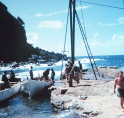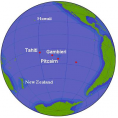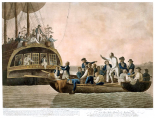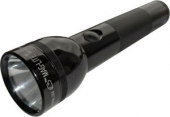Pitcairn Islands
South Pacific Oceanresources
Level of surfing
Competent
Quality of surf
Average
Call code
64
Net code
pn
Area
5
Coastline
0 km
Climate
Tropical Maritime
Hazards
Very Isolated, Difficult Access
Best Months
May - September
Population
50
Currency
New Zealand Dollar (NZD)
Time Zone
(UTC-8)
Special Requirements
Non tourist Friendly
surfing

US DoD: Adamstown Harbour Lefts; 2006
A pitching deck, the creak of well worn timbers, the cracking of sail and canvas...tied to the mast. Things have changed a little I guess from when Jack London and Josef Conrad wrote their haunting Pacific infused epics but it hasnt changed everythwhere. There are corners of this earth where that mythos still holds true, and most of those corners are here in the South Pacific.
The main source of swell here is from the intense lows that circle the earth south of Australia, these lows spin off northwards with blessed regularity, peppering the entire region with generous SE to SW groundswell from March to September. Australia and New Zealand see the bulk of these swells. These countries cast a very tall shadow across the rest of the Pacific and hence many other islands in their wake can suffer from swell difusion. December to February is cyclone season. Unpredictable cells can deliver swell in a 360 radius, lighting up rarely breaking reefs and points facing every conceivable direction.
The South Pacific trade winds are some of the most consistent in the world, generally from the East with slight seasonal variation. This is the largest Ocean on the planet and these winds easily generate regular rideable swell. Onshore conditions can be a problem on east facing coastlines but peeling yourself out for an early surf will usually bring some relief.
In the North Pacific it is the intense lows descending from the Aleutians that deliver NE to NW swells from October to March. Hawaii is ideally placed to make best use of this energy but other coastlines in the region have their own less publicised and far less crowded gems.
Jun to October also sees rarer hurricane swell radiate out from southern Mexico. This energy is often felt right throughout Polynesia. With so many energy vectors at work it is very hard not to find a wave.
Places such as Pitcairn that offer rideable options on every coast will ensure that regadlesss of the conditions, somewhere there will be a wave. In fact quite often there will be a very good one.
introduction

Wikid77: Simple map of globe, seen from area of Pitcairn Island and Tahiti; 19 January 2007
The Pitcairn Islands, officially named the Pitcairn, Henderson, Ducie, and Oeno Islands, are a group of four tiny islands in the southern Pacific Ocean. The islands are a British overseas territory (formerly British colony), the last remaining in the Pacific. Only Pitcairn Island — the second smallest — is inhabited.
history

Robert Dodd: The mutineers turning Lt Bligh and part of the officers and crew adrift from HMAV Bounty, 29 April 1789; 2 Oct 1790
Originally, the Pitcairn Islands (Ducie, Henderson, Oeno and Pitcairn) were settled by Polynesians who appear to have lived on Pitcairn and Henderson for several centuries. The interesting thing is that the islands were uninhabited when they were discovered by Europeans, however, archaeologists believe that Polynesians were living on Pitcairn as late as the 15th century.
Today’s Pitcairn Island population is descended from British sailors and Tahitians. The mutineers of the HMS Bounty settled the island in 1790, along with their Tahitian women and a few Tahitian men. The initial period of settlement was quite difficult for th them. Although the settlers were able to survive by farming and fishing, they were suffering from different diseases; alcoholism and murders were quite often and took took the lives of most mutineers and Tahitian men. Fueled by homemade alcohol, disputes over women eventually resulted in the violent deaths of all but two of the men – Adams and Young. But six years later Young died of asthma and Adams was left with eleven women and 23 children. He turned to the Bounty Bible, which led him to repentance and a new outlook on life. With the help of the Bible, he educated the children, built a school and organized the community into a Christian way of life.
In 1808 Pitcairn was re-discovered by the American ship Topaz, but reports of the find went largely ignored; then, on 17 September 1814 the island community was again accidentally ‘discovered’ by two British frigates. Surprised by their find and impressed by the character of the residents, they chose to leave this community. Adams died on the island on the 6 of March 1829 at the age of 63, forty-two years after the Bounty set sail on its fateful voyage. A varied succession of leadership followed until an orderly government was established in 1893.
what to pack

Nordelch: Flashlight; 7 January 2005
It is better to take as much as you can, as options can bi limited on the island. Trainers, loose clothing - everything for the warm weather. Definitely take along some bug repellent spray, good sunscreen and sunglasses! It essential to take your own medicines with you.
Electricity (240V) is available only for a few hours in the morning and several hours in the evening, so take batteries!!!
You may also need a pair of waterproof boots and a good backpack if you plan to explore the islands. Depending on the season tropical rains can be quite often, so it’s a good idea to take something waterproof if you plan to go outside. There's not much to buy here, so you would want to bring all your necessities - ie. toiletries.






